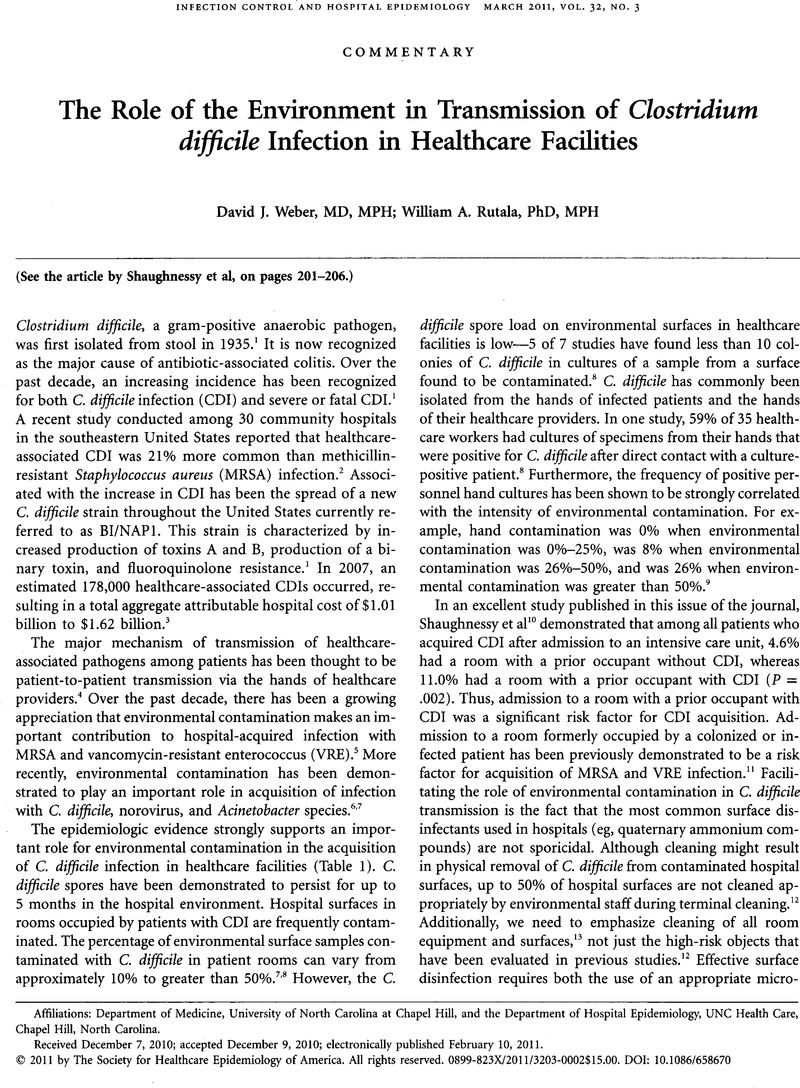Crossref Citations
This article has been cited by the following publications. This list is generated based on data provided by Crossref.
Murphy, Cathryn L.
Macbeth, Deborough A.
Derrington, Petra
Gerrard, John
Faloon, Jacinta
Kenway, Kellie
Lavender, Samantha
Leonard, Simon
Orr, Amanda
Tobin, Dayani
and
Carling, Philip
2011.
An assessment of high touch object cleaning thoroughness using a fluorescent marker in two Australian hospitals.
Healthcare infection,
Vol. 16,
Issue. 4,
p.
156.
Rutala, William A.
and
Weber, David J.
2011.
Are Room Decontamination Units Needed to Prevent Transmission of Environmental Pathogens?.
Infection Control & Hospital Epidemiology,
Vol. 32,
Issue. 8,
p.
743.
Munoz-Price, L. Silvia
Birnbach, David J.
Lubarsky, David A.
Arheart, Kristopher L.
Fajardo-Aquino, Yovanit
Rosalsky, Mara
Cleary, Timothy
DePascale, Dennise
Coro, Gabriel
Namias, Nicholas
and
Carling, Philip
2012.
Decreasing Operating Room Environmental Pathogen Contamination through Improved Cleaning Practice.
Infection Control & Hospital Epidemiology,
Vol. 33,
Issue. 9,
p.
897.
Rutala, William A.
Gergen, Maria F.
and
Weber, David J.
2012.
Efficacy of Different Cleaning and Disinfection Methods against Clostridium difficile Spores: Importance of Physical Removal versus Sporicidal Inactivation.
Infection Control & Hospital Epidemiology,
Vol. 33,
Issue. 12,
p.
1255.
Badger, Victor O.
Ledeboer, Nate A.
Graham, Mary Beth
and
Edmiston, Charles E.
2012.
Clostridium difficile.
Journal of Parenteral and Enteral Nutrition,
Vol. 36,
Issue. 6,
p.
645.
Weber, David J.
and
Rutala, William A.
2013.
Understanding and Preventing Transmission of Healthcare-Associated Pathogens Due to the Contaminated Hospital Environment.
Infection Control & Hospital Epidemiology,
Vol. 34,
Issue. 5,
p.
449.
Shama, G.
and
Malik, D.J.
2013.
The uses and abuses of rapid bioluminescence-based ATP assays.
International Journal of Hygiene and Environmental Health,
Vol. 216,
Issue. 2,
p.
115.
Donskey, Curtis J.
2013.
Does improving surface cleaning and disinfection reduce health care-associated infections?.
American Journal of Infection Control,
Vol. 41,
Issue. 5,
p.
S12.
Weber, David J.
Anderson, Deverick J.
Sexton, Daniel J.
and
Rutala, William A.
2013.
Role of the environment in the transmission of Clostridium difficile in health care facilities.
American Journal of Infection Control,
Vol. 41,
Issue. 5,
p.
S105.
Dettenkofer, Markus
2013.
Healthcare environment decontamination.
Healthcare infection,
Vol. 18,
Issue. 1,
p.
47.
DuPont, Herbert L
2014.
Challenges and opportunities in the management ofClostridium difficileinfection.
Expert Review of Gastroenterology & Hepatology,
Vol. 8,
Issue. 8,
p.
863.
Lopez, Gerardo U.
Kitajima, Masaaki
Havas, Aaron
Gerba, Charles P.
Reynolds, Kelly A.
and
Schaffner, D. W.
2014.
Evaluation of a Disinfectant Wipe Intervention on Fomite-to-Finger Microbial Transfer.
Applied and Environmental Microbiology,
Vol. 80,
Issue. 10,
p.
3113.
Knelson, Lauren P.
Williams, David A.
Gergen, Maria F.
Rutala, William A.
Weber, David J.
Sexton, Daniel J.
and
Anderson, Deverick J.
2014.
A Comparison of Environmental Contamination by Patients Infected or Colonized with Methicillin-Resistant Staphylococcus aureus or Vancomycin-Resistant Enterococci: A Multicenter Study.
Infection Control & Hospital Epidemiology,
Vol. 35,
Issue. 7,
p.
872.
Jou, Justine
Ebrahim, John
Shofer, Frances S.
Hamilton, Keith W.
Stern, John
and
Han, Jennifer H.
2015.
Environmental Transmission ofClostridium difficile: Association Between Hospital Room Size andC. difficileInfection.
Infection Control & Hospital Epidemiology,
Vol. 36,
Issue. 5,
p.
564.
OGURA, Yuya
OZAWA, Tomoko
NOJIMA, Yasuhiro
and
KIKUNO, Ritsuko
2015.
Antimicrobial Efficacy of Complex-Type Chlorine-Based Disinfectant Cleaner Against Several Pathogenic Microorganisms.
Japanese Journal of Infection Prevention and Control,
Vol. 30,
Issue. 6,
p.
391.
Cadnum, Jennifer L.
Tomas, Myreen E.
Sankar, Thriveen
Jencson, Annette
Mathew, J. Itty
Kundrapu, Sirisha
and
Donskey, Curtis J.
2016.
Effect of Variation in Test Methods on Performance of Ultraviolet-C Radiation Room Decontamination.
Infection Control & Hospital Epidemiology,
Vol. 37,
Issue. 5,
p.
555.
Gingras, Guillaume
Guertin, Marie-Hélène
Laprise, Jean-François
Drolet, Mélanie
Brisson, Marc
and
Vedantam, Gayatri
2016.
Mathematical Modeling of the Transmission Dynamics of Clostridium difficile Infection and Colonization in Healthcare Settings: A Systematic Review.
PLOS ONE,
Vol. 11,
Issue. 9,
p.
e0163880.
Guh, Alice Y
Adkins, Susan Hocevar
Li, Qunna
Bulens, Sandra N
Farley, Monica M
Smith, Zirka
Holzbauer, Stacy M
Whitten, Tory
Phipps, Erin C
Hancock, Emily B
Dumyati, Ghinwa
Concannon, Cathleen
Kainer, Marion A
Rue, Brenda
Lyons, Carol
Olson, Danyel M
Wilson, Lucy
Perlmutter, Rebecca
Winston, Lisa G
Parker, Erin
Bamberg, Wendy
Beldavs, Zintars G
Ocampo, Valerie
Karlsson, Maria
Gerding, Dale N
and
McDonald, L Clifford
2017.
Risk Factors for Community-Associated Clostridium difficile Infection in Adults: A Case-Control Study.
Open Forum Infectious Diseases,
Vol. 4,
Issue. 4,
Ray, Amy J.
Deshpande, Abhishek
Fertelli, Dennis
Sitzlar, Brett M.
Thota, Priyaleela
Sankar C, Thriveen
Jencson, Annette L.
Cadnum, Jennifer L.
Salata, Robert A.
Watkins, Richard R.
Sethi, Ajay K.
Carling, Philip C.
Wilson, Brigid M.
and
Donskey, Curtis J.
2017.
A Multicenter Randomized Trial to Determine the Effect of an Environmental Disinfection Intervention on the Incidence of Healthcare-Associated Clostridium difficile Infection.
Infection Control & Hospital Epidemiology,
Vol. 38,
Issue. 7,
p.
777.
Napolitano, Lena M.
and
Edmiston, Charles E.
2017.
Clostridium difficile disease: Diagnosis, pathogenesis, and treatment update.
Surgery,
Vol. 162,
Issue. 2,
p.
325.



